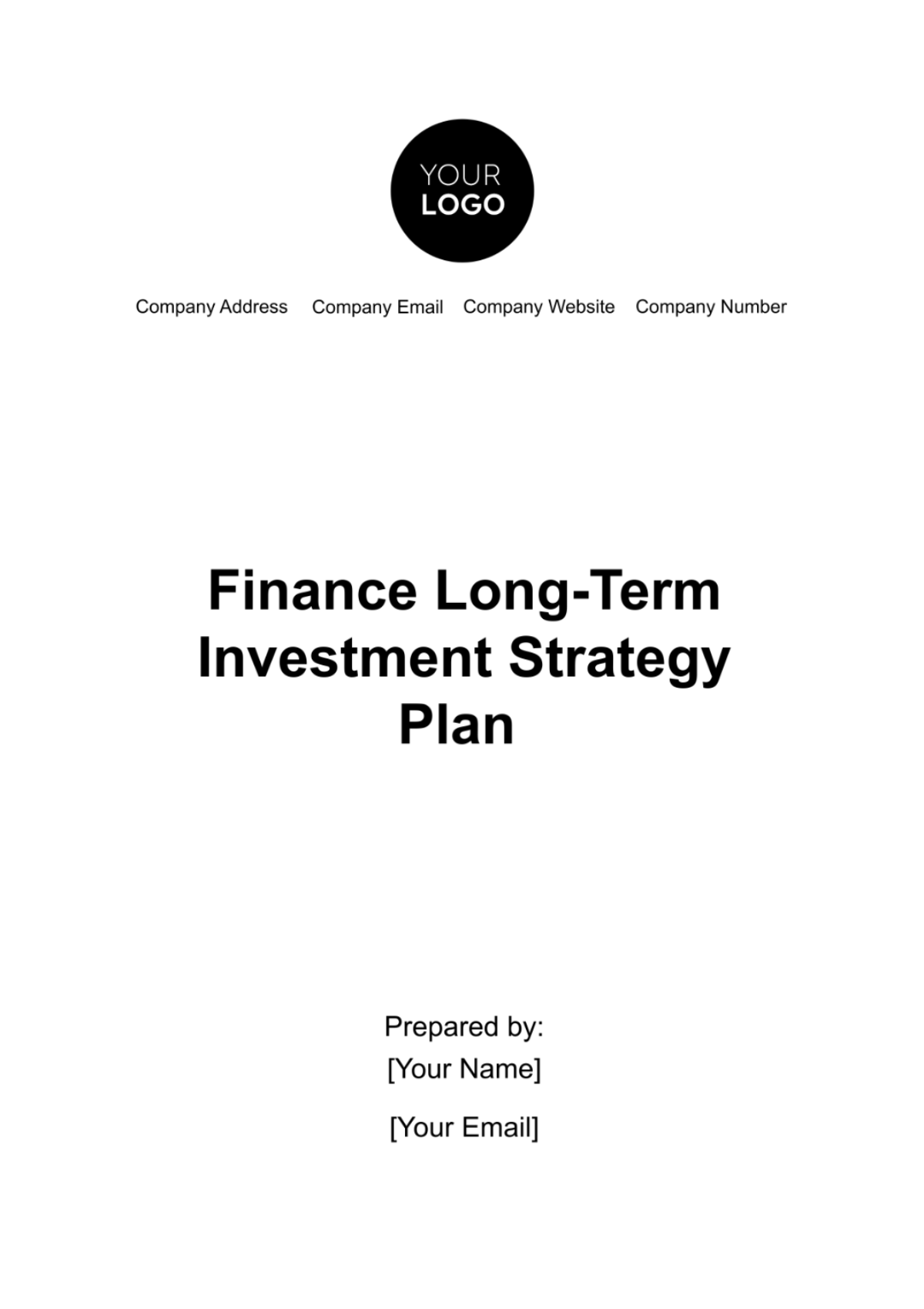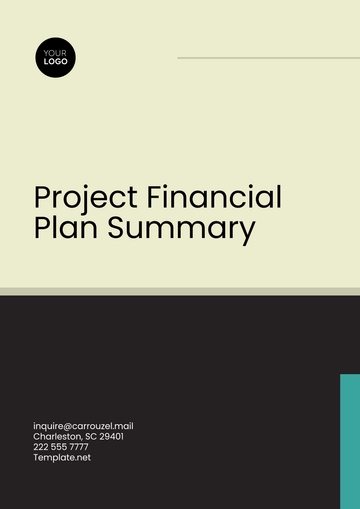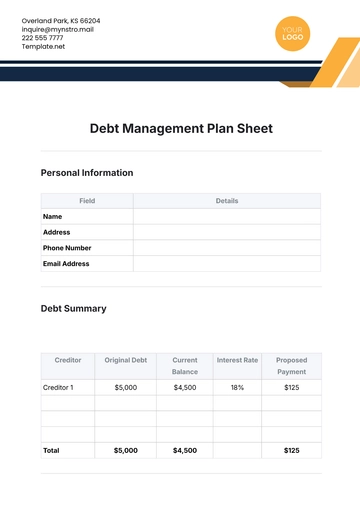Free Finance Long-Term Investment Strategy Plan

1. Executive Summary
This Long-Term Investment Strategy Plan, crafted for [Your Company Name], presents a comprehensive roadmap to guide our financial endeavors and investment decisions over the next 5 to 10 years. We aim to not only safeguard the company's assets but also to fuel sustainable growth through strategic investments. The plan, tailored to align with our core business values and objectives, is a testament to our commitment to fiscal prudence and strategic foresight.
Our primary investment objectives focus on three pivotal areas: growth, income, and safety. Growth entails the enhancement of asset value over the long term, ensuring our investments appreciate and contribute significantly to the company's net worth. Income generation, through dividends and interest, is targeted to provide a steady cash flow, bolstering our operational liquidity. Safety, a key consideration, revolves around protecting the principal amount invested, thereby minimizing the risk of capital loss.
The investment policy, a cornerstone of this plan, has been meticulously designed to reflect a moderate to high-risk tolerance, accepting short-term market fluctuations for potential long-term gains. Our asset allocation strategy emphasizes diversification, spreading investments across various asset classes such as stocks, bonds, real estate, and alternative investments. This diversified approach is crucial in mitigating risks and capitalizing on growth opportunities across different sectors and economic conditions.
Our strategies are multifaceted, encompassing equity investments in growth and value stocks, fixed-income investments through a laddered bond approach, alternative investments in realms like real estate and private equity, and maintaining liquidity through cash equivalents. These strategies are aligned with our objectives of growth, income, and safety, ensuring a balanced portfolio that can weather market volatility while capitalizing on growth opportunities.
Performance monitoring and risk management are integral components of this plan. Regular reviews, benchmarking against relevant indices, and adjustments in response to market dynamics ensure our investment portfolio remains robust and aligned with our strategic objectives. The plan also includes a comprehensive risk management strategy, emphasizing diversification and hedging to mitigate potential risks.
In summary, this Long-Term Investment Strategy Plan for [Your Company Name] is a dynamic, well-structured guide to navigate the complexities of the financial markets. It aims to position the company on a path of sustainable growth, sound income generation, and robust risk management, paving the way for financial stability and long-term success.
2. Company Overview
Name: _____________________[Your Company Name]
Address: ___________________[Your Company Address]
Website: ___________________[Your Company Website]
Social Media: _______________[Your Social Media]
Established in [Year of Establishment], [Your Company Name] has carved a niche in the dynamic world of finance and investment, emerging as a pivotal player in the [Industry/Market Sector]. Our journey began with a vision to demystify the complexities of financial markets and make investment opportunities accessible and profitable for a diverse range of clients.
At [Your Company Name], we specialize in offering a comprehensive suite of investment solutions tailored to meet the unique needs of our clients. Our expertise spans across various domains including equity trading, fixed-income securities, wealth management, and alternative investments. We have built a reputation for our innovative investment approach, combining traditional methodologies with cutting-edge technology to optimize returns while minimizing risks.
Our business model is centered around client-centricity. We believe in building long-term relationships with our clients, understanding their financial goals, and aligning our strategies to help them achieve these objectives. Our team of seasoned financial experts and analysts brings a wealth of knowledge and insight, ensuring that our clients receive informed and strategic advice.
In addition to our core investment services, [Your Company Name] is deeply involved in financial research and market analysis. We provide our clients with up-to-date market insights and forecasts, helping them stay ahead of market trends and make informed decisions. Our research division is renowned for its thorough analysis and ability to identify potential investment opportunities in various sectors and geographies.
Our commitment to excellence and integrity has been the cornerstone of our success. As we continue to grow and evolve, [Your Company Name] remains dedicated to delivering outstanding service and value to our clients, ensuring that their financial aspirations are realized. We are not just a financial services provider; we are partners in our clients' financial journeys, guiding them towards a prosperous future.
3. Investment Objectives
The investment objectives of [Your Company Name] are meticulously crafted to ensure a balanced approach toward achieving long-term financial stability and growth. These objectives are categorized into primary and secondary objectives, each playing a crucial role in guiding our investment strategies and decisions.
Primary Objectives
The primary objectives are the cornerstone of our investment philosophy and are essential for driving the overall direction of our investment activities.
Objective | Description |
Growth | Our foremost objective is to enhance the asset value over a long-term period. This involves investing in assets with the potential for appreciation in value over time, thereby increasing the overall worth of our investment portfolio. |
Income | Generating a steady stream of income through dividends and interest is pivotal. This objective focuses on creating a consistent and reliable source of income, which can be reinvested or used to support operational expenses. |
Safety | Safeguarding the principal amount invested is crucial. This involves carefully balancing risk and reward in our investment choices to protect against significant losses, thereby ensuring the preservation of our capital. |
Secondary Objectives
Secondary objectives complement our primary goals, providing additional layers of strategy to refine our investment approach.
Objective | Description |
Liquidity | Maintaining adequate liquidity is essential for meeting operational needs and responding to opportunities or emergencies. Investments are managed to ensure that a portion of the portfolio can be readily converted to cash without significant losses. |
Tax Efficiency | Optimizing investments for tax purposes is a key consideration. This involves strategically planning and managing investments to minimize tax liabilities, thereby maximizing after-tax returns. |
These objectives collectively form a comprehensive framework guiding [Your Company Name]'s investment decisions. They are designed to ensure a well-rounded approach to investing, balancing growth and income generation with risk management and operational efficiency. Regular reviews and adjustments to these objectives may be made in response to changing market conditions and the evolving financial goals of our company.
4. Investment Policy
Our Investment Policy serves as the foundation for our investment approach and decision-making process. It outlines the strategic criteria and policies that govern how we allocate assets, manage risks, and ensure compliance with legal and financial standards. This policy is designed to align with our overarching investment objectives, ensuring a disciplined and structured approach to achieving our long-term financial goals.
Criteria | Policy |
Asset Allocation | Diversification across stocks, bonds, real estate, and alternative investments. |
Risk Tolerance | Moderate to high, accepting short-term volatility for long-term gains. |
Investment Horizon | 5-10 years with periodic reviews. |
Liquidity Requirements | [Specify Percentage] of portfolio easily liquidated within [Specify Time Frame]. |
Tax Considerations | Utilize tax-advantaged accounts and strategies. |
Legal & Regulatory Compliance | Adherence to all applicable financial regulations. |
A. Asset Allocation: This is the process of distributing investments across various asset classes such as stocks, bonds, real estate, and alternative investments. The objective is to create a diversified portfolio that balances potential risks and returns in line with our investment goals.
B. Risk Tolerance: Our policy recognizes the balance between risk and reward. We have identified our risk tolerance as moderate to high, acknowledging that short-term market volatility can be a pathway to long-term gains. This approach is critical in navigating the complexities of the financial markets while seeking sustainable growth.
C. Investment Horizon: The policy sets a clear investment horizon of 5 to 10 years, with periodic reviews. This long-term perspective is essential for allowing our investments to mature and realize their full potential, especially in fluctuating market conditions.
D. Liquidity Requirements: Liquidity is a crucial aspect of our investment policy. It specifies the percentage of our portfolio that should be readily convertible to cash within a defined time frame, ensuring that we can meet short-term obligations and take advantage of emerging investment opportunities.
E. Tax Considerations: Tax efficiency is an integral part of our investment strategy. We aim to utilize tax-advantaged accounts and strategies that maximize after-tax returns, thus enhancing the overall effectiveness of our investments.
F. Legal & Regulatory Compliance: Adherence to all applicable financial regulations and legal standards is non-negotiable. Our policy mandates compliance with all relevant laws and regulatory guidelines, ensuring that our investment activities are conducted ethically and legally.
This Investment Policy is a living document, subject to periodic review and adjustment to reflect changes in market conditions, regulatory landscapes, and our company’s financial objectives. It is a guiding framework that enables [Your Company Name] to navigate the investment landscape with clarity, purpose, and strategic direction.
5. Investment Strategies
In this section, we delineate the comprehensive investment strategies that [Your Company Name] will employ as part of our long-term investment plan. These strategies are carefully crafted to align with our investment objectives and policy, ensuring a balanced and diversified portfolio. They are categorized into four main areas: Equity Investments, Fixed-Income Investments, Alternative Investments, and Cash and Equivalents. Each category has its specific focus, types, and strategic approach:
Investment Strategy | Aspect | Details |
Equity Investments | Target Sectors | [Specify Sectors] |
Strategy | Focused on a blend of growth and value stocks, with an emphasis on companies that demonstrate sustainable business models and maintain strong positions in the market. This approach is designed to capitalize on both market stability and growth potential. | |
Fixed-Income Investments | Types | Corporate bonds, government securities, municipal bonds. |
Strategy | Employing a laddered bond approach to manage interest rate risk while ensuring a regular stream of income. This method allows for diversification within the fixed-income portfolio and helps mitigate the impact of fluctuating interest rates. | |
Alternative Investments | Types | Real estate, private equity, hedge funds. |
Strategy | Focus on opportunistic investments that target long-term capital appreciation. This includes investing in assets and markets that provide potential for significant growth over an extended period. | |
Cash and Equivalents | Role | To provide liquidity and safety within the portfolio. |
Instruments | Money market funds, certificates of deposit. These instruments are chosen for their low-risk profile and ease of conversion to cash, ensuring availability of funds when needed. |
6. Performance Monitoring and Review
In this crucial section, we outline the framework for Performance Monitoring and Review for [Your Company Name]. This process is fundamental in ensuring that our investment strategies are not only effective but also aligned with our evolving objectives and the dynamic nature of the financial markets. Regular monitoring and review enable us to make informed decisions and necessary adjustments to our investment portfolio, thereby optimizing our overall financial performance.
The following table provides a detailed overview of the key components of our Performance Monitoring and Review process:
Review Component | Description |
Performance Metrics | Essential metrics such as Return on Investment (ROI), alpha, beta, and standard deviation are used to measure and evaluate the performance of our investments. These metrics provide insights into the risk-adjusted returns of our portfolio and its relative performance against market benchmarks. |
Benchmarking | Our investment performance is regularly compared against relevant indices and the performance of peers. This benchmarking process helps in assessing the effectiveness of our investment strategies relative to the broader market and industry standards. |
Frequency | We conduct quarterly reviews to closely monitor the performance and health of our portfolio. Additionally, an annual comprehensive analysis is undertaken to evaluate long-term performance trends and strategic alignment. |
Adjustments | Portfolio rebalancing is carried out in response to market changes and shifts in our company objectives. This involves adjusting the composition of our portfolio to maintain alignment with our risk tolerance, investment horizon, and strategic goals. |
Through this structured approach to Performance Monitoring and Review, [Your Company Name] ensures a disciplined and proactive management of our investment portfolio. This ongoing process is vital for maintaining the resilience and efficacy of our investment strategies in the face of changing market conditions and internal company dynamics.
7. Risk Management
Effective risk management is paramount to the success and sustainability of [Your Company Name]'s investment strategy. Our risk management framework is designed to identify, assess, and mitigate the various risks that can impact our investment portfolio. This proactive approach ensures that we not only preserve capital but also maintain a strong position to capitalize on potential opportunities. Below are the key components of our risk management strategy:
Risk Assessment
A. Market Risk: We regularly evaluate the impact of market fluctuations on our portfolio. This includes monitoring economic indicators, market trends, and geopolitical events that could influence market conditions.
B. Credit Risk: Assessing the creditworthiness of entities we invest in is crucial. We analyze the financial stability and credit history of these entities to mitigate the risk of investment defaults.
C. Liquidity Risk: Ensuring that our investments can be readily converted into cash without significant loss is vital. We continuously monitor the liquidity of our investments to ensure quick access to funds when needed.
Diversification
A. Across Asset Classes: We spread our investments across various asset classes such as equities, bonds, real estate, and alternative investments. This diversification helps in reducing the impact of volatility in any single asset class on our overall portfolio.
B. Geographical Diversification: Investing in different geographical regions reduces the risk associated with a particular market or economy. This global diversification strategy helps in balancing risks and taking advantage of growth opportunities worldwide.
Hedging Strategies
A. Derivatives and Financial Instruments: To mitigate risk, we employ hedging strategies using derivatives and other financial instruments. These can include options, futures, and swaps, which are used to offset potential losses in our investment portfolio.
B. Dynamic Hedging: Our hedging strategies are not static; they are continuously reviewed and adjusted based on market conditions and portfolio performance. This dynamic approach allows us to effectively manage risk while remaining flexible to changing market dynamics.
Through these risk management practices, [Your Company Name] aims to create a resilient investment portfolio capable of withstanding market uncertainties while striving for optimal performance. Regular reviews and updates to our risk management strategies ensure that they remain effective and aligned with our overall investment objectives.
8. Conclusion and Next Steps
[Your Company Name]'s long-term investment strategy is designed to balance growth, income, and risk management to achieve our financial objectives. The next steps involve detailed implementation of the outlined strategies, regular monitoring, and adjustments as necessary.
Prepared by: _____________[Your Name]
Contact: _________________[Your Personal Email], [Your User Phone]
- 100% Customizable, free editor
- Access 1 Million+ Templates, photo’s & graphics
- Download or share as a template
- Click and replace photos, graphics, text, backgrounds
- Resize, crop, AI write & more
- Access advanced editor
Introducing Template.net's Finance Long-Term Investment Strategy Plan Template. Editable and customizable with our Ai Editor Tool, this template empowers you to craft robust investment strategies tailored to your financial goals. Navigate the complexities of long-term investing with ease and precision, ensuring a secure financial future with Template.net's innovative solutions.
You may also like
- Finance Plan
- Construction Plan
- Sales Plan
- Development Plan
- Career Plan
- Budget Plan
- HR Plan
- Education Plan
- Transition Plan
- Work Plan
- Training Plan
- Communication Plan
- Operation Plan
- Health And Safety Plan
- Strategy Plan
- Professional Development Plan
- Advertising Plan
- Risk Management Plan
- Restaurant Plan
- School Plan
- Nursing Home Patient Care Plan
- Nursing Care Plan
- Plan Event
- Startup Plan
- Social Media Plan
- Staffing Plan
- Annual Plan
- Content Plan
- Payment Plan
- Implementation Plan
- Hotel Plan
- Workout Plan
- Accounting Plan
- Campaign Plan
- Essay Plan
- 30 60 90 Day Plan
- Research Plan
- Recruitment Plan
- 90 Day Plan
- Quarterly Plan
- Emergency Plan
- 5 Year Plan
- Gym Plan
- Personal Plan
- IT and Software Plan
- Treatment Plan
- Real Estate Plan
- Law Firm Plan
- Healthcare Plan
- Improvement Plan
- Media Plan
- 5 Year Business Plan
- Learning Plan
- Marketing Campaign Plan
- Travel Agency Plan
- Cleaning Services Plan
- Interior Design Plan
- Performance Plan
- PR Plan
- Birth Plan
- Life Plan
- SEO Plan
- Disaster Recovery Plan
- Continuity Plan
- Launch Plan
- Legal Plan
- Behavior Plan
- Performance Improvement Plan
- Salon Plan
- Security Plan
- Security Management Plan
- Employee Development Plan
- Quality Plan
- Service Improvement Plan
- Growth Plan
- Incident Response Plan
- Basketball Plan
- Emergency Action Plan
- Product Launch Plan
- Spa Plan
- Employee Training Plan
- Data Analysis Plan
- Employee Action Plan
- Territory Plan
- Audit Plan
- Classroom Plan
- Activity Plan
- Parenting Plan
- Care Plan
- Project Execution Plan
- Exercise Plan
- Internship Plan
- Software Development Plan
- Continuous Improvement Plan
- Leave Plan
- 90 Day Sales Plan
- Advertising Agency Plan
- Employee Transition Plan
- Smart Action Plan
- Workplace Safety Plan
- Behavior Change Plan
- Contingency Plan
- Continuity of Operations Plan
- Health Plan
- Quality Control Plan
- Self Plan
- Sports Development Plan
- Change Management Plan
- Ecommerce Plan
- Personal Financial Plan
- Process Improvement Plan
- 30-60-90 Day Sales Plan
- Crisis Management Plan
- Engagement Plan
- Execution Plan
- Pandemic Plan
- Quality Assurance Plan
- Service Continuity Plan
- Agile Project Plan
- Fundraising Plan
- Job Transition Plan
- Asset Maintenance Plan
- Maintenance Plan
- Software Test Plan
- Staff Training and Development Plan
- 3 Year Plan
- Brand Activation Plan
- Release Plan
- Resource Plan
- Risk Mitigation Plan
- Teacher Plan
- 30 60 90 Day Plan for New Manager
- Food Safety Plan
- Food Truck Plan
- Hiring Plan
- Quality Management Plan
- Wellness Plan
- Behavior Intervention Plan
- Bonus Plan
- Investment Plan
- Maternity Leave Plan
- Pandemic Response Plan
- Succession Planning
- Coaching Plan
- Configuration Management Plan
- Remote Work Plan
- Self Care Plan
- Teaching Plan
- 100-Day Plan
- HACCP Plan
- Student Plan
- Sustainability Plan
- 30 60 90 Day Plan for Interview
- Access Plan
- Site Specific Safety Plan





























